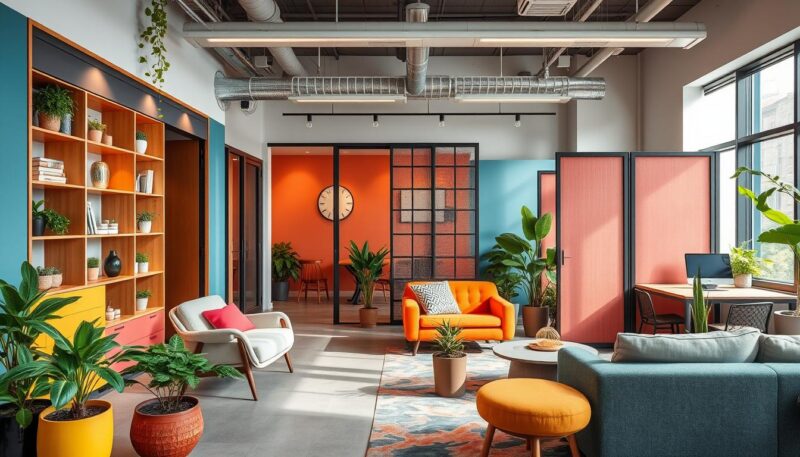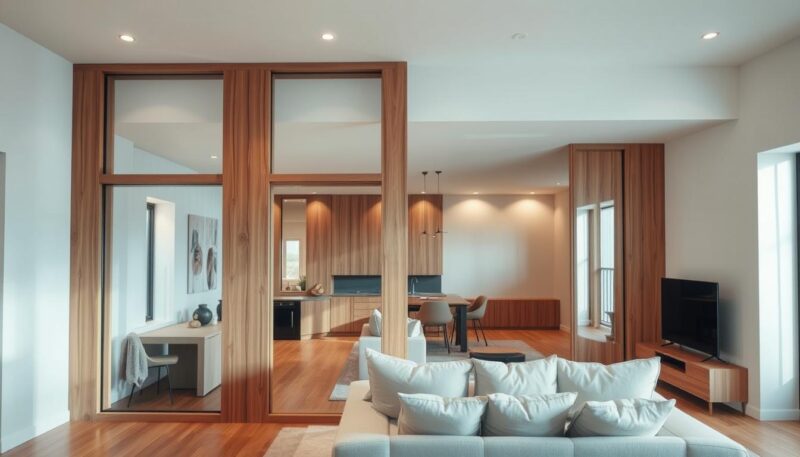Building a wall to divide a room can be an excellent way to optimize space while also adding an aesthetic touch to your interior design. Whether you’re aiming to create a cozy nook or establish distinct areas in an open floor plan, a well-executed partition can transform your living space. Let’s dive into some creative room layout inspiration and practical tips to get started on your room division project.
One popular approach is to refurbish old architectural elements like staircases or vintage doors. Architects like VW Fowlkes recommend using these elements to introduce a unique character to your space. Integrating refurbished staircases can enable you to separate zones while allowing natural light to flood multiple areas. This blend of historic and functional elements not only enhances room layout inspiration but also adds a touch of charm to your home.
Incorporating materials like glass and steel is another effective strategy for those looking to maintain light flow and visual connectivity between rooms. The experts at Four Brothers Design + Build suggest using these materials to create a modern, airy partition that serves both function and form. Glass pocket doors, for instance, can create the perfect balance between separation and openness, making them an ideal solution for space optimization.
For those more inclined towards DIY projects, utilizing contrasting colors and textures can add visual interest and define separate areas within a room. You can create an intimate reading corner or a private guest space by painting one section of the room a different color or using textures like reclaimed wood or macramé hanging dividers.
Bookshelves and freestanding units also offer excellent opportunities for creative room ideas. You can place a tall, wide bookcase between two areas to serve as both a room divider and additional storage. Modern bookshelves now double as fold-down desks, making them particularly useful in small living spaces where every inch of space must be efficiently utilized.
Lastly, consider unconventional room dividers like hanging shelves or indoor trellises. These solutions can carve out specific areas without blocking light or making the space feel cramped. Hanging shelves from the ceiling or installing an indoor trellis can add a seamless connection between indoor and outdoor elements, further enhancing room layout inspiration.
From architectural elements to DIY projects, the possibilities are endless when it comes to dividing a room creatively. Each of these ideas enhances space optimization while adding a fresh twist to your interior design, giving you the freedom to tailor your home to your unique taste and needs.
Stay tuned as we explore various aspects of DIY wall construction, materials, tools, and creative layout inspirations in the upcoming sections of this article. Whether you’re a seasoned handyman or a first-time DIY enthusiast, we have all the tips and tricks you need to achieve the perfect room transformation.
DIY Wall Construction: Materials and Tools Needed
Building a partition wall on your own can be a fulfilling and cost-effective way to divide a room. Understanding the materials needed and tools for building walls, along with effective framing techniques and proper drywall installation, is essential to achieving a professional finish.
Essential Materials for Building a Partition Wall
Quality materials are crucial for constructing a sturdy partition wall. You’ll need drywall panels, wooden frames, nails, and screws. Ensure you have properly measured studs, usually 92 5/8 inches for an 8-foot ceiling, with spacing at 16 inches on center for adequate support. A standard setup often includes 11 pieces of 2×4 lumber (3 pieces at 10 feet and 8 pieces at 8 feet), 3 sheets of 4×8 underlayment, and specific amounts of Tapcon concrete anchors, Simpson Strong-Tie stud plate ties, and SPAX screws.
Tools You Will Need for the Job
Having the right tools for building walls ensures precision and efficiency. Commonly used tools include hammers, drills, tape measures, levels, and nailers. For instances requiring advanced equipment, you may opt for a Ridgid pneumatic palm nailer with a Ridgid compressor for driving nails, a rotary hammer for drilling, and a brad nailer for fastening underlayment. Additionally, using painter’s tape for marking placement on the floor can save time and help maintain accuracy.
Basic Framing Techniques
Effective framing techniques are essential for a robust partition wall. Standard stud placement at 16 inches on center provides adequate support for drywall installation and other wall coverings. For walls taller than eight feet, consider using horizontal or herringbone blocking to add rigidity. Stud plates, such as those from Simpson Strong-Tie, can provide additional stability when attaching studs to bottom and top plates. If you’re framing around door openings, headers constructed by sandwiching plywood between lumber pieces should be used to ensure strength.
Drywall Installation and Finishing Tips
Installing drywall is a crucial step that requires meticulous attention. Begin by screwing the drywall panels to the framed walls, ensuring they fit tightly. Fiberglass batts can be added for sound dampening between rooms. Next, tape the seams, apply joint compound, and sand the surfaces smoothly. This preparation provides a seamless canvas for painting or applying wallpaper, offering a polished and professional appearance.
Creative Room Division Ideas and Layout Inspiration
When it comes to layout planning and exploring room division ideas, integrating creative solutions can transform your space into a multifunctional haven. Here, we delve into various inspiring methods to utilize architectural elements, glass and steel design elements, bookshelves, freestanding units, sliding or pocket doors, and curtains and folding screens to create aesthetically pleasing interior partition walls.
Utilize Architectural Elements
Incorporating architectural elements such as half walls, platform beds with built-in storage, and custom wood focal walls can add visual interest and provide practical layout planning. Designer Ginny Macdonald’s entryway projects, for example, effectively use architectural features to divide spaces without sacrificing style or functionality.
Incorporate Glass and Steel Design Elements
For a modern touch, consider glass and steel partitions that maintain light flow while delineating different areas. Kristen Mendoza’s projects demonstrate how interior partition walls made of industrial glass can create an open yet separated feel. Similarly, expansive windows and doors, as featured in Cotswold cottage renovations, can serve as stylish room dividers.
Integrate Bookshelves and Freestanding Units
Bookshelves and freestanding units offer flexibility and functionality. IKEA frequently features in this category, offering a range of options that double as room dividers. Melanie Turner’s use of macramé wall hangings to enclose desk areas showcases how multifunctional space design can be achieved with creativity and a small investment.
Use Sliding or Pocket Doors
Sliding or pocket doors are ideal for sleek functionality in room division ideas. These doors, highlighted in the designs of Wayne Pottow and Jeannette Whitson, are perfect for both saving space and distinguishing different areas within a larger room.
Experiment with Curtains and Folding Screens
Simple and elegant, curtains and folding screens offer easily changeable solutions to room division. The Boegger chain curtain room dividers and the 70s inspired hand-painted beaded bamboo retro room dividers present trendy yet functional additions to any space.
With endless possibilities in layout planning and design, room division can be both creative and practical. From DIY solutions to stylish ready-made options, there is something to suit every taste and requirement, ensuring your space is both beautiful and multifunctional.
Conclusion
Building a wall to divide a room provides numerous benefits, from creating additional privacy to enhancing the overall aesthetics of your home. Whether you opt for a permanent or temporary partition, selecting the right materials and techniques is crucial. Plasterboard, wood, and concrete blocks offer great durability for permanent walls, while gypsum boards, plywood, and glass are popular for temporary solutions due to their flexibility and ease of installation. Gypsum boards, in particular, are favored for their soundproofing capabilities, making them an excellent choice for both residential and office settings.
When undertaking a budget-friendly renovation, it’s essential to consider cost-effective materials like Homasote board and clear pine. These not only keep expenses low but also provide quality and functionality. Soundproofing options are indispensable in offices where noise reduction is critical, and partition walls with fire-resistant properties enhance safety in both commercial and residential buildings. Modular and adjustable solutions like sliding doors or freestanding units further boost the versatility and practical usage of the space, tailored to your specific needs.
A step-by-step guide is immensely helpful in ensuring your project runs smoothly. By following the outlined techniques and tips, you can confidently partition any space whether you’re creating a new home office, study area, or an additional room. Remember, even temporary walls do not generally require permits, but always check your local building codes to avoid potential issues. From essential tools and materials to creative partition ideas, this guide is designed to help you successfully transform your environment. With just a bit of planning and attention to detail, your room division can become a structurally pleasing and functionally enhanced space.


